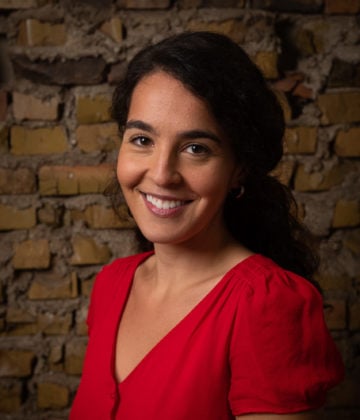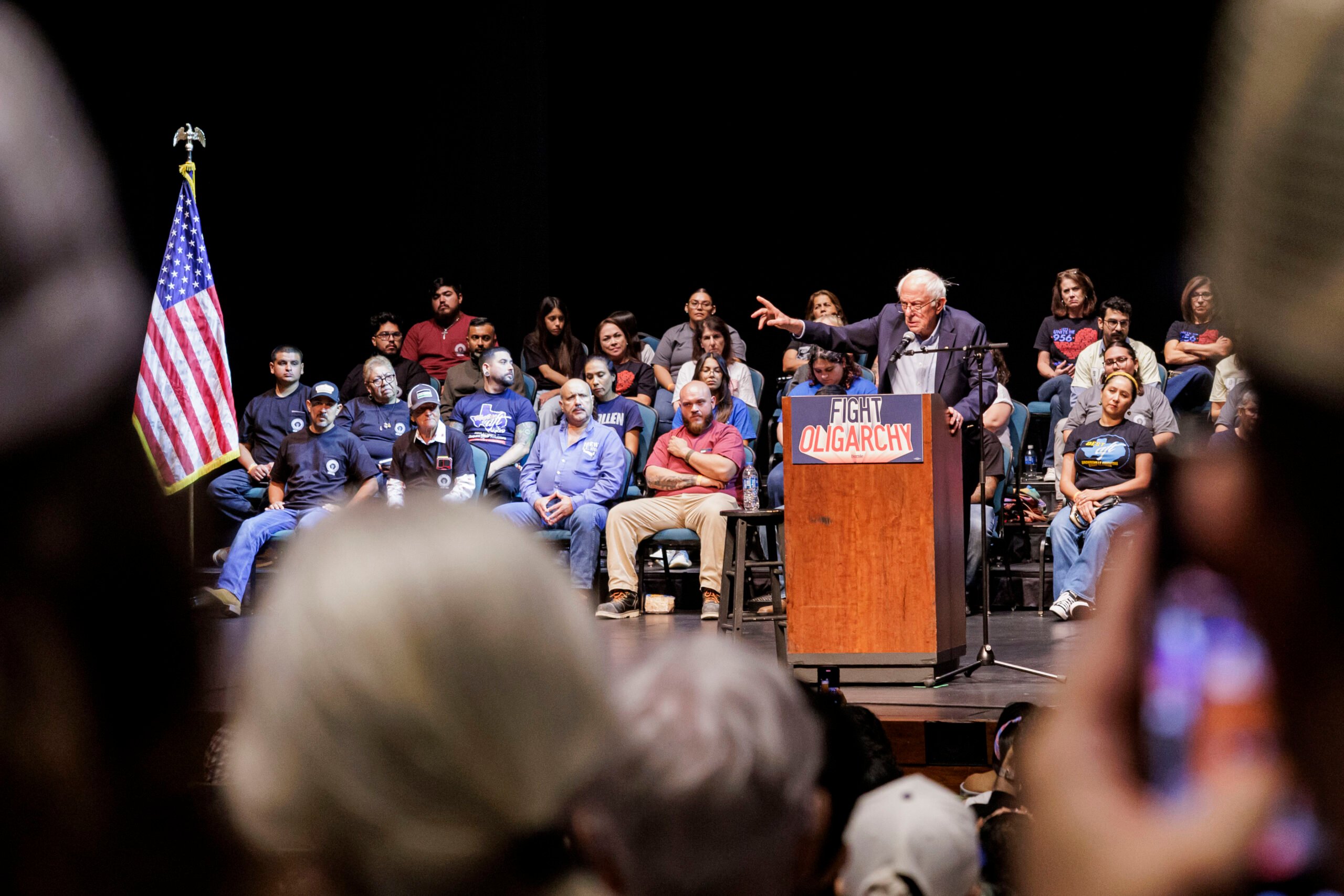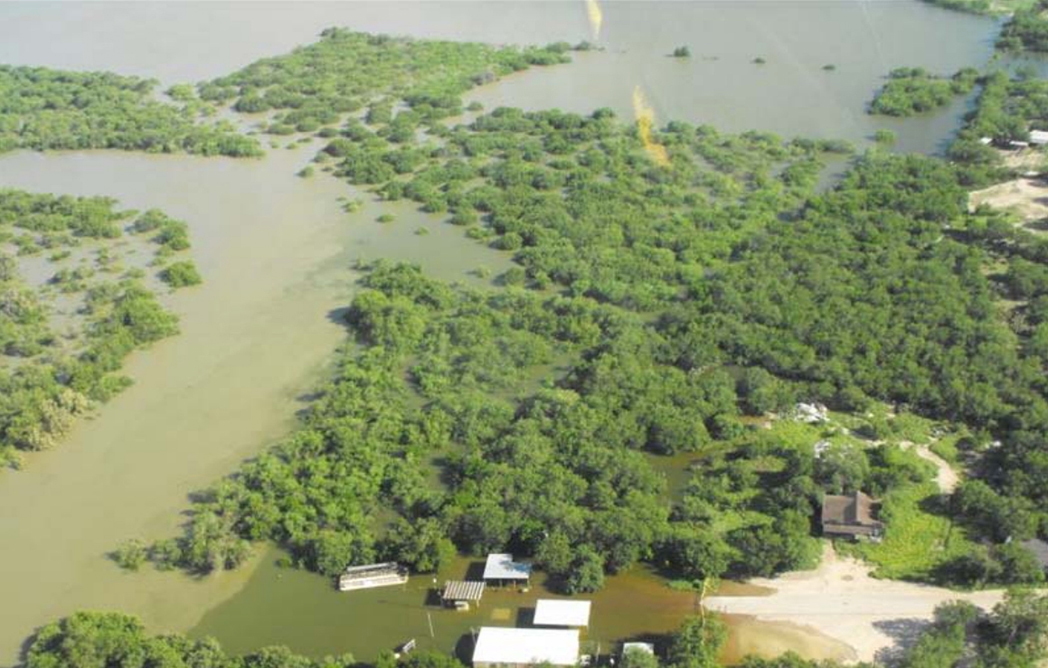Under Water
Colonias on the Texas-Mexico border are hit hard even by small storms. For a local nonprofit, the solution lies in affordable, sustainable housing. But how do you rebuild in an area that keeps flooding?
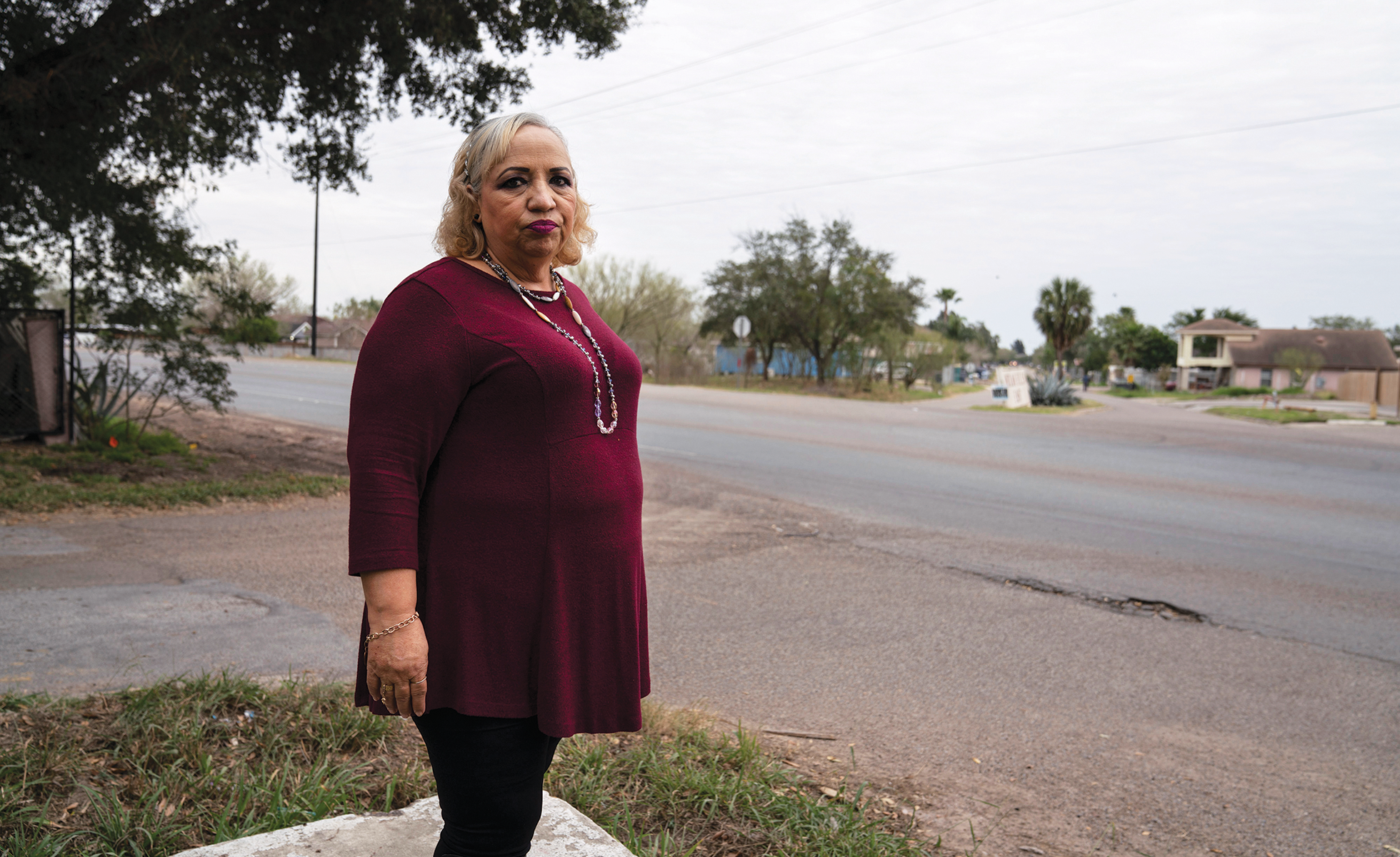
Lourdes Salinas stood at the end of her street and watched as her neighborhood filled with water.
She awoke on the morning of June 20, 2018, to the sound of heavy rain pouring off the roof of her white-brick home. Salinas grabbed an umbrella and hurried through the front yard, past a chain-link fence where a handwritten sign instructs visitors to grite, yell, in the absence of a doorbell. She dodged potholes brimming with water as she made her way down the slick slope of a hill. Salinas paused on the edge of North Baseline Road, which divides her colonia, Indian Hills, into its east and west sides. A sodden American flag hung in a neighbor’s front lawn behind her; nearby, a sign posted on a tree read “Keep Texas beautiful. Proud community.” The salmon-colored mini-market across the street advertised milk, eggs, tacos, Sunday barbacoa; just beyond, rain filled front lawns, soaking old car parts and clothes hung out to dry. Kids swam in the murky water, dotted with debris and trash, as though it were a pool. A canal close by threatened to overflow. Salinas, now 59, became frantic. “Oh my god, get out of the colonia!” she shouted. “Get your families, get out, get out!”
Salinas’ Hidalgo County colonia, along with many poor, unincorporated border communities in the Rio Grande Valley, holds water like a bowl; even small storms can strand residents for days. But this time was different. The rain was relentless, pouring down from her home at the top of Indian Hills West and sloping into Indian Hills East, where floodwaters had been steadily rising since early that morning.
Salinas later learned that this storm, which the National Weather Service dubbed the Great June Flood of 2018, dumped several feet of water on neighborhoods across the region, shuttering businesses and halfway submerging cars. As a community organizer with a local housing nonprofit, Salinas knew many of her neighbors’ homes weren’t built to withstand any storms at all. She gripped an emergency contact book and her cell phone, its cover emblazoned with “Jesus” in curly letters. Salinas called everyone she could think of who might have a truck large enough to get through to help people evacuate.
“In the ’80s, we were just working so hard to get potable water into the colonias. Now the work is to get stormwater out.”
Finally, help arrived—but not in the way she’d expected. Among the first emergency response vehicles to show up were white pickups with the characteristic green stripe and seal of Border Patrol.
Salinas’ phone started buzzing. “Tell them to leave,” worried residents texted. She and other organizers had spent the past few years teaching immigrant families their rights, training them not to open the door to anyone. Now immigration officials were here, at their homes, asking residents—some undocumented—to get in their trucks. “People didn’t want to get out in an emergency, because they were scared that they were going to take them to jail, instead of to a shelter,” Salinas says.
Quickly, she flipped through her contact book and made more calls: the county commissioner’s office, the local television station. It was later that night when she reached her boss, Proyecto Azteca Executive Director Ann Cass, at home. “I’m like, ‘Oh my gosh, what do I do?’” Salinas remembers. “How do I get these people out?”
For years, community organizers in colonias have fought for better drainage, housing improvements, and basic infrastructure. In makeshift homes relegated to the outskirts of cities, colonia residents have long been left to fend for themselves. As climate change intensifies storms and flooding, advocates in colonias are grappling with a particularly acute version of a question that poor communities around the country are facing: how, or whether, to keep rebuilding in a place that won’t stop flooding.
Cass meets me in the small white-and-red house that serves as Proyecto Azteca’s headquarters in San Juan, about 20 miles west of Indian Hills. Her desk is stacked with papers; a sign on the wall reads, “Creative clutter is better than idle neatness.”
Proyecto Azteca’s work is centered on the idea that safe and affordable housing is at the heart of everything else. Since 1991, the nonprofit has been constructing new homes for some of the poorest colonia residents in Hidalgo County, where about one-third of residents live in poverty. The organization, which has 12 employees, has built almost 1,000 new homes in about 130 of the county’s more than 900 colonias. Eligible residents are responsible for paying taxes and insurance, as well as contributing some “sweat equity” labor on the home. The need for better housing is increasingly urgent: Poor communities on the Texas-Mexico border feel the effects of climate change more severely than almost anyone else. An estimated 500,000 people live in colonias in Texas. Here, decades of neglect have trapped families in a cycle of poverty that is amplified by persistent storms and a disaster recovery process that lawsuits in recent years have alleged is discriminatory and dramatically undercounts the needs of poor people.
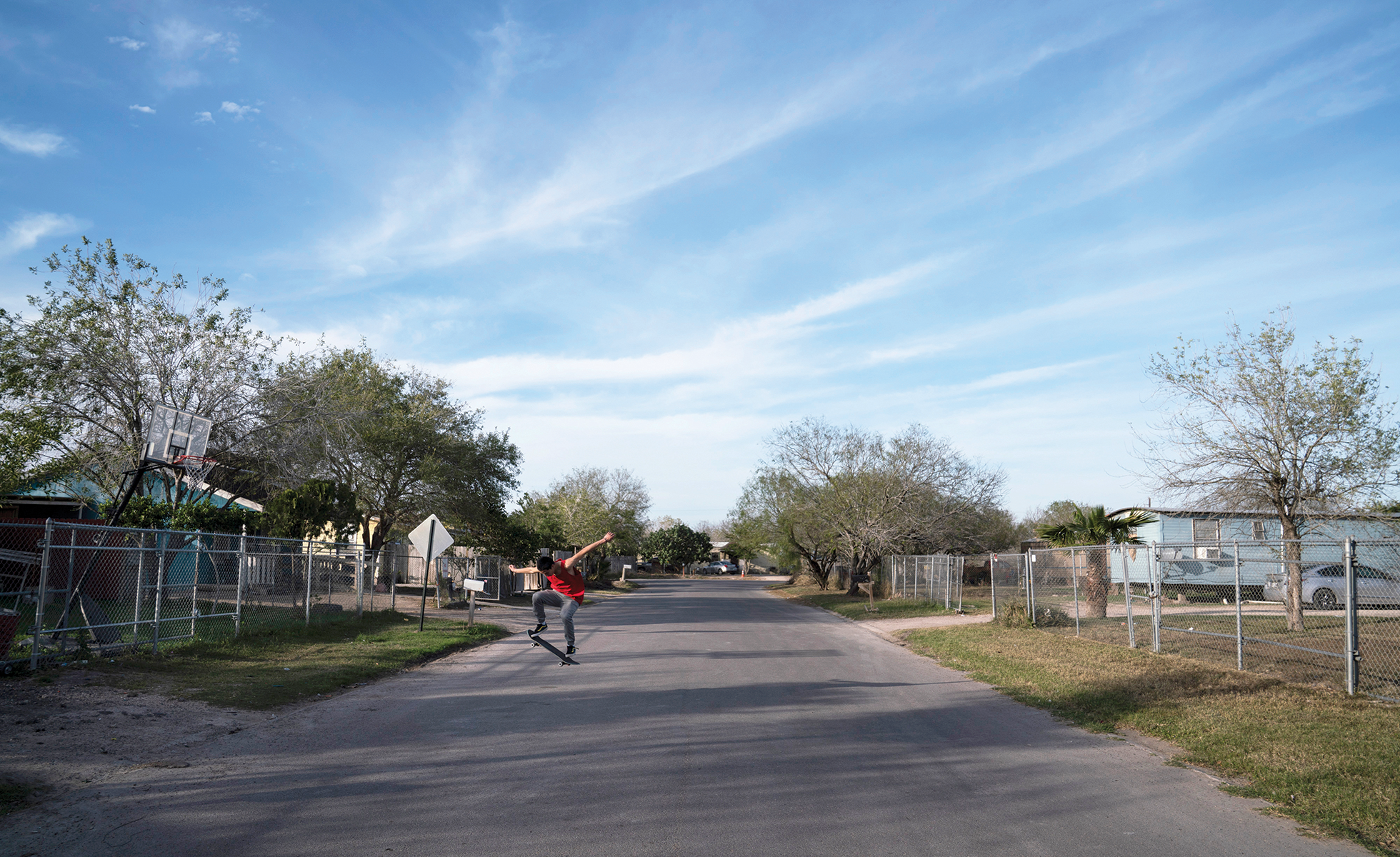
“Especially with global warming and climate change, we don’t want to build in a neighborhood that floods,” Cass says. But that’s increasingly hard to track, as flood maps are outdated and more and more areas are flooding that haven’t before. “As the county keeps expanding and asphalt or cement goes down, the water changes where it goes. So we’ve been talking about maybe elevating all the houses,” she says. “There’s all sorts of research being done now … on how to build a home that’s really going to be sustainable.”
Now, colonia residents are especially vulnerable to dual threats: the impending hurricane season this summer and the COVID-19 pandemic. In the Rio Grande Valley, which has some of the highest poverty and uninsured rates in the country, there were 689 confirmed COVID-19 cases as of Monday morning, with 44 percent in Hidalgo County. Cass says Proyecto Azteca office employees are working from home and construction on houses through the program has continued, following pandemic guidelines. She says she’s working to tap county resources to further help families. People living in substandard housing are at increased risk: They may not be able to afford to stay home from work, often live crowded with many other people, and may not have adequate sanitation or a safe place to quarantine. For people living in colonias, “they don’t really even have the ability in a lot of cases to have somebody in a separate bedroom from everybody else,” if they were to test positive for the virus, says Ann Millard, a retired Texas A&M University professor who lives in the area. “It just kind of keeps compounding on itself in terms of the barriers and the challenges.”
Mexican immigrants began settling in Texas border colonias in the 1950s. Many low-wage farmworkers who were priced out of cities bought cheap plots of land in unincorporated areas and saved up to build whatever kind of home they could afford. Colonias are designated as such by the state because they’ve historically lacked basic infrastructure like paved roads, electricity, and potable water. Conditions in many colonias have improved a lot in recent years thanks to tireless organizing in the communities, but much remains to be done. Salinas is still advocating for new roads and streetlights in Indian Hills West, where she’s lived for 25 years. It’s a safety concern, she says, especially combined with the fact that many residents don’t have registered addresses. Paramedics often don’t know the right address to come to; even if they did, they’d struggle to find it in the dark. Whenever Salinas hears an ambulance nearby, she comes outside to point out the right house. In a recent incident, she says, paramedics drove by three times before they found her neighbor, who was having a heart attack. That motivated Salinas to get her own address registered, just in case.
These days, the big issue for colonias is drainage, Cass says. “It’s kind of ironic: I was an administrator for United Farm Workers back in the ’80s, and we were just working so hard to get potable water into the colonias. Now the work is to get stormwater out.”
But building a sustainable, flood-proof home can be complicated and costly. Meanwhile, the demand for new homes is huge, and Proyecto Azteca is already limited, with a waitlist of several thousand families, plus more joining each day. It costs about $50,000 for Proyecto Azteca to build a new home, Cass says. The organization determines where to build based on grants and funding it receives, and where the need is greatest. Often the original homes it replaces are patched together from found items like corrugated metal and wooden boards; sometimes they’re old trailers, or the home was destroyed and the family has nothing. Cass shows me photos of a house built from scrap wood and partly covered by tarps, with an outhouse connected to a neighbor’s sewer line. When that family’s new Proyecto Azteca home was finished on Christmas years ago, the father said it was the best present for his kids to take their first hot baths. In another case, Cass recalls, a home was constructed in part from old political yard signs.
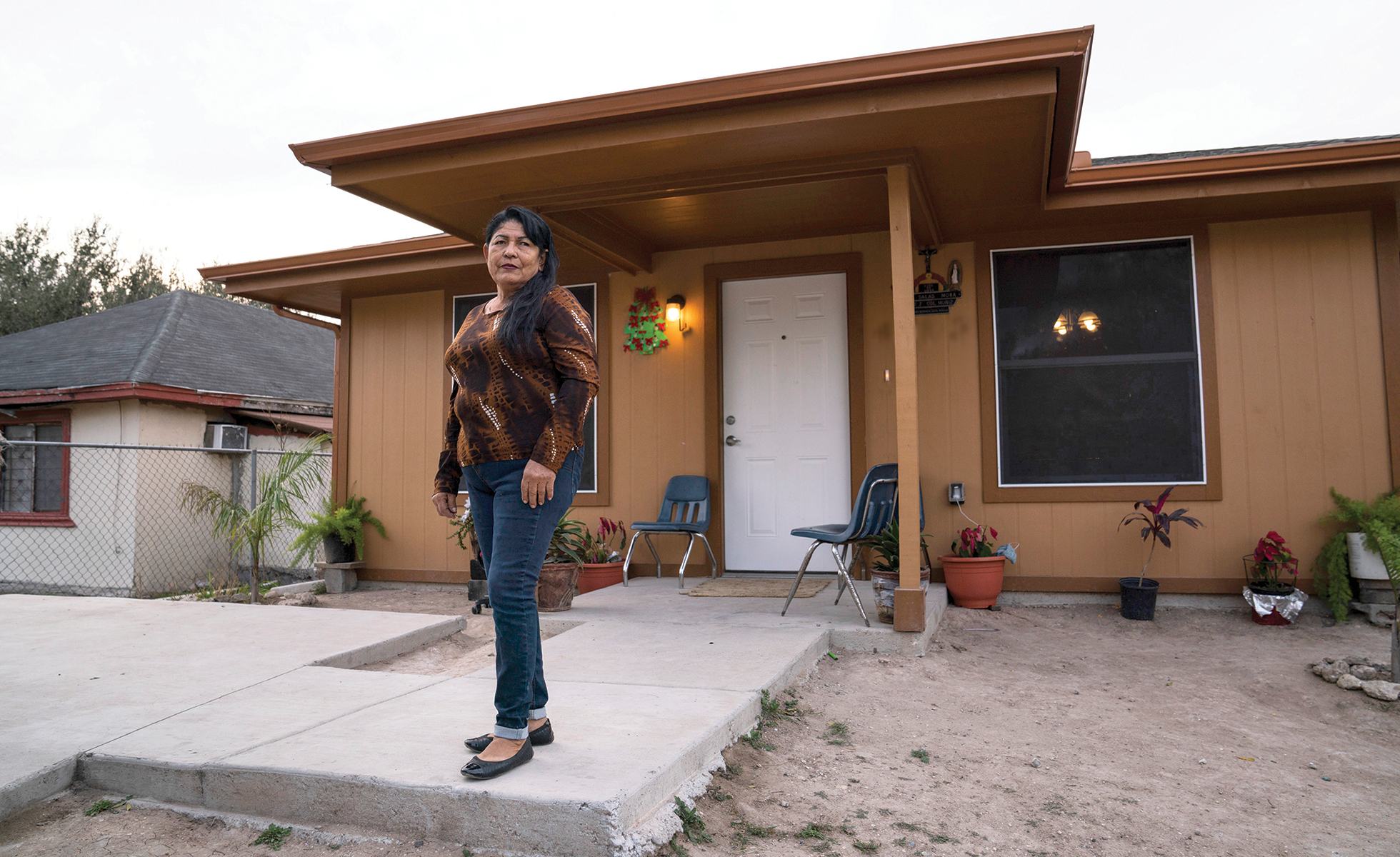
That many people won’t evacuate during storms makes having a sturdier, more resilient home all the more important.
“When it looks like rain is coming, a lot of people get very anxious, wondering, ‘Will the kids be able to go to school tomorrow? … What’s going to happen?’” Cass says. Immigration fears are one of the biggest challenges the area faces in emergency storm situations, she explains, especially since going north requires crossing inland Border Patrol checkpoints. (U.S. Customs and Border Patrol did not respond to questions from the Observer about whether helping to evacuate during storms, like in Indian Hills, is routine, or how frequently it occurs. Cass says now there are ongoing conversations with colonia residents so they won’t be surprised if it happens again.) Then there are financial obstacles to evacuating, too: “A lot of people don’t have the money to evacuate,” she says. “What are they going to do?”
Before she got a new home through Proyecto Azteca, Lupita Mora and her family used to paint the exterior of their small, two-bedroom home in the Muñiz colonia, 9 miles northeast of San Juan, a new color every year. The fresh coat of paint, added at the insistence of her husband, was an ineffective distraction from what was inside: the holes in the floor where rats crawled up, the walls and windowsills where patches of mold spread.
The whole house tilted to one side, remembers Mora, 67, and there was a gap of about 4 inches between the front door and the floor. When it rained outside, it rained in the Mora house, too. The backyard would flood, becoming a black lake with a smell that permeated their home, plus an accompanying swarm of mosquitoes. Sometimes, the house made the family sick with rashes and fevers. Twice, Mora says, she got pneumonia brought on by mold in the home; on one occasion, it sent her to the hospital for three days.
But even in heavy storms, the family stayed. They bought the small home and the quarter-acre lot it sat on for $26,000 nearly two decades ago, after they came from Rio Bravo, Mexico, to try to find better treatment for Mora’s husband’s cancer. Like many colonia residents, he worried about evacuating and leaving behind what little they had.
“A lot of people don’t have the money to evacuate. What are they going to do?”
When it comes to disaster recovery, government assistance is notoriously slow and insufficient, often leaving low-income residents to try to fix what they can themselves. The region didn’t receive FEMA public assistance after the June 2018 flood because the eligible damage was well below the threshold of nearly $37 million, the agency says. That left cash-strapped local entities on the hook for millions in infrastructure repairs, according to David Fuentes, Hidalgo County Commissioner for Precinct 1 (which includes Indian Hills) and a board member of the drainage district. The average FEMA individual assistance housing award in Hidalgo, Cameron, and Jim Wells counties was just under $5,800.
When the flood came to Indian Hills, FEMA was still doling out recovery funding for 2008’s Hurricane Dolly after a court sided with colonia residents in a yearslong legal battle. Texas’ General Land Office is looking into new ways to distribute flood mitigation funds in the Valley—part of the $4 billion Congress appropriated for mitigation projects in Texas, prompted by Hurricane Harvey—a possibility leaders here are heartened by. But the agenda for a December public hearing by the GLO in Weslaco covered only 2015 and 2016 floods in the area. A new law passed by the Legislature last year with Hurricane Harvey in mind dedicates funding for flood control projects around the state; Fuentes is hopeful Hidalgo County will benefit in 2021.
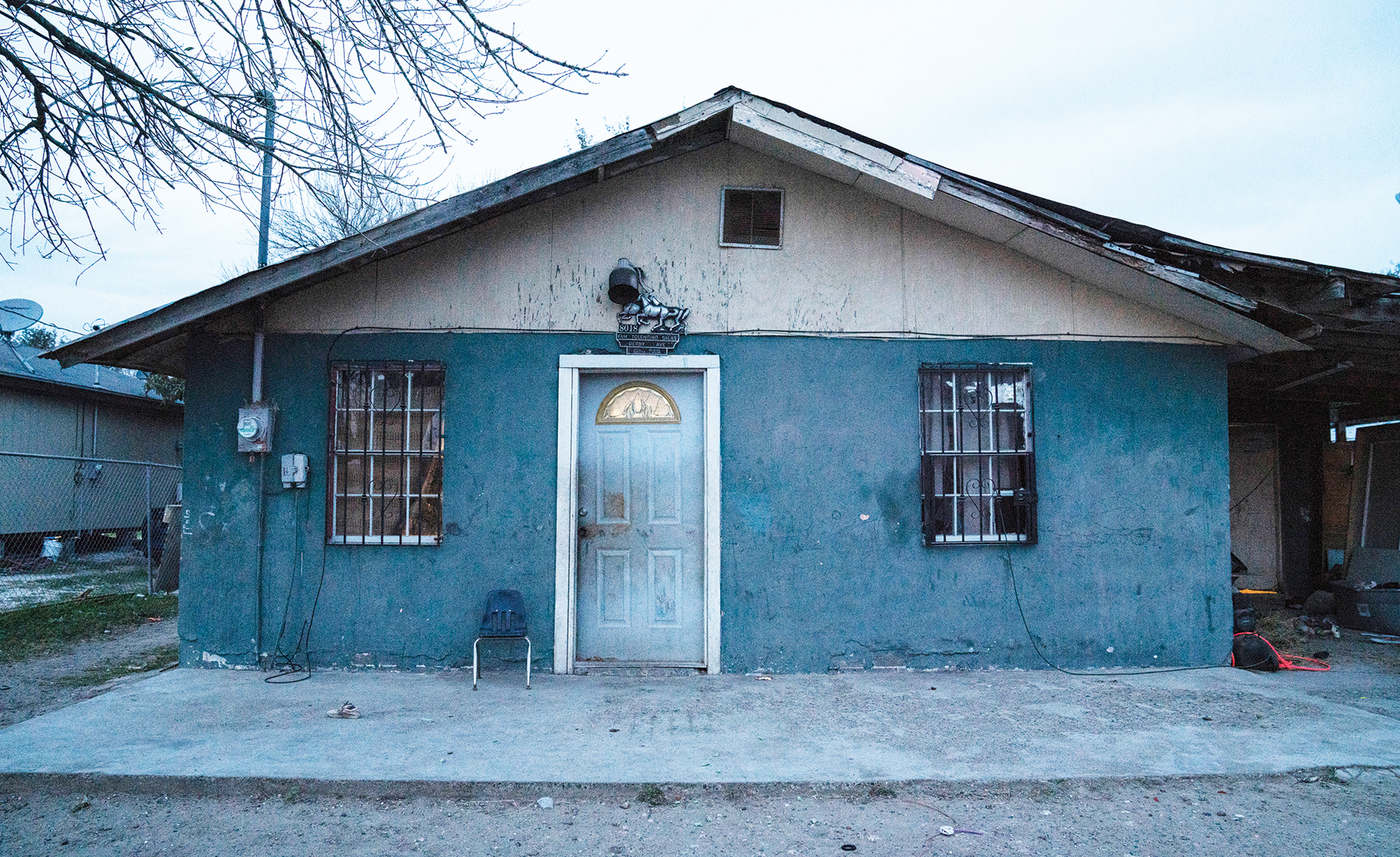
In the meantime, Proyecto Azteca is focusing on how to construct more-resilient homes. It’s already building on mounds of dirt a foot or so off the ground, but the organization is considering ways to elevate future structures more and further reinforce roofs. The nonprofit Brownsville Community Development Corporation, which offers similar self-help housing assistance in Cameron and Willacy counties, is expanding because “the need for affordable housing is tremendous everywhere,” says Josué Ramírez, who recently joined the organization from Texas Housers. Other groups are also training residents on better ways to rebuild. “The problem is, we keep building the same homes,” says Martha Sanchez, a community organizer with LUPE who has advocated for better drainage and housing in colonias for years. “People build their own homes because they can’t afford to hire someone,” Sanchez says. They cut corners expecting that housing rules won’t be enforced; the result is a cycle of building and rebuilding. Changes will cost more in the short term but last longer, she says. “We need more Aztecas,” she says of the nonprofit. “One is not enough.”
Magdalena Capetillo watched the 2018 flooding unfold from a window of her Proyecto Azteca home in Indian Hills East. Before the new house was built in 2015, Capetillo, her husband, and their four kids had all crammed into a two-bedroom trailer on a small lot they bought for about $10,500 a few years before. They’d lived in the trailer only six months when it caught fire; the family lost all their possessions in half an hour.
Shortly before, a handyman had come by to fix some of the electric wiring in the trailer, which he warned wasn’t properly connected and could be dangerous. Then he made what Capetillo, 37, now sees as a prophetic prediction: that someday, the family would be living in a real house on this lot.
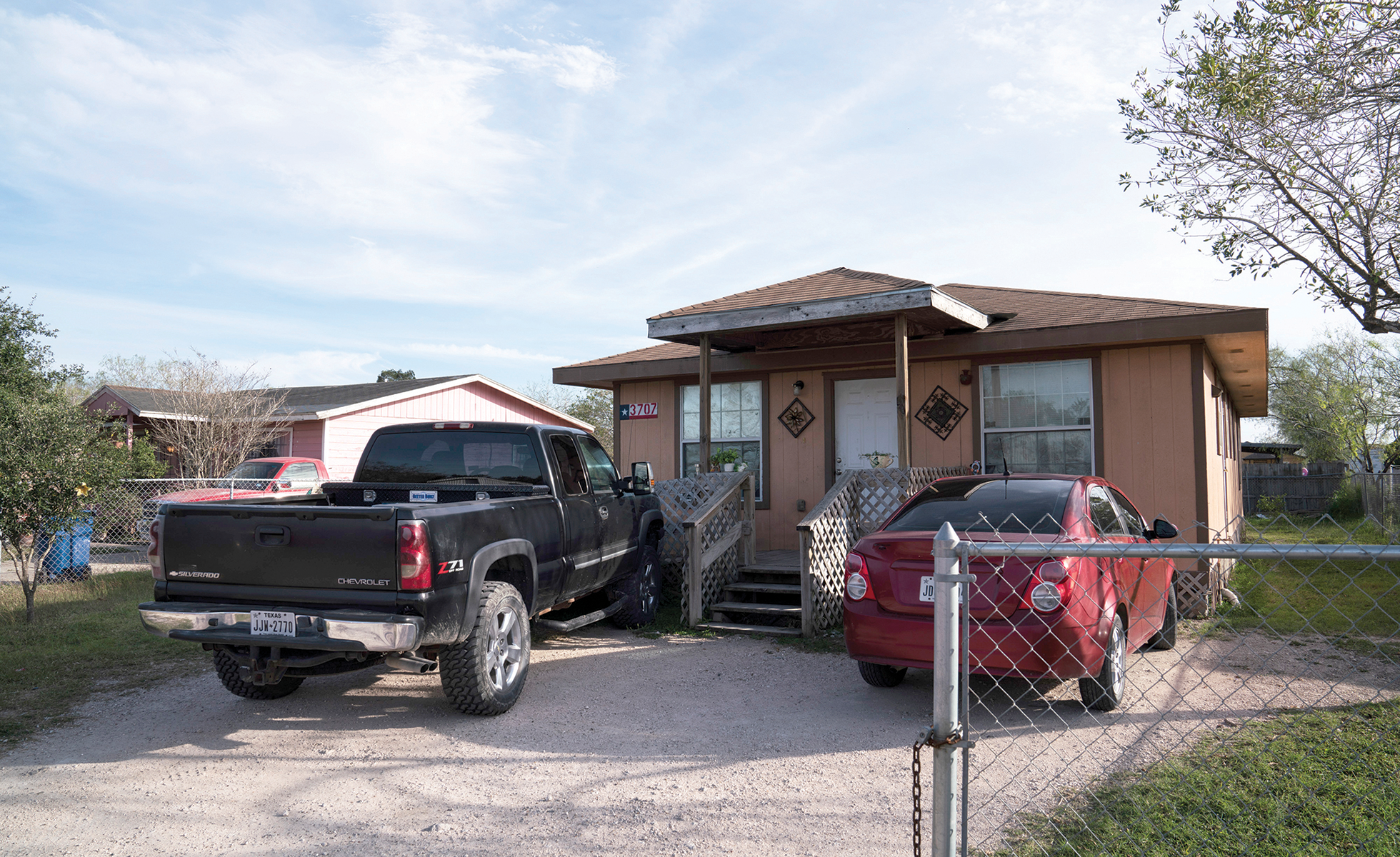
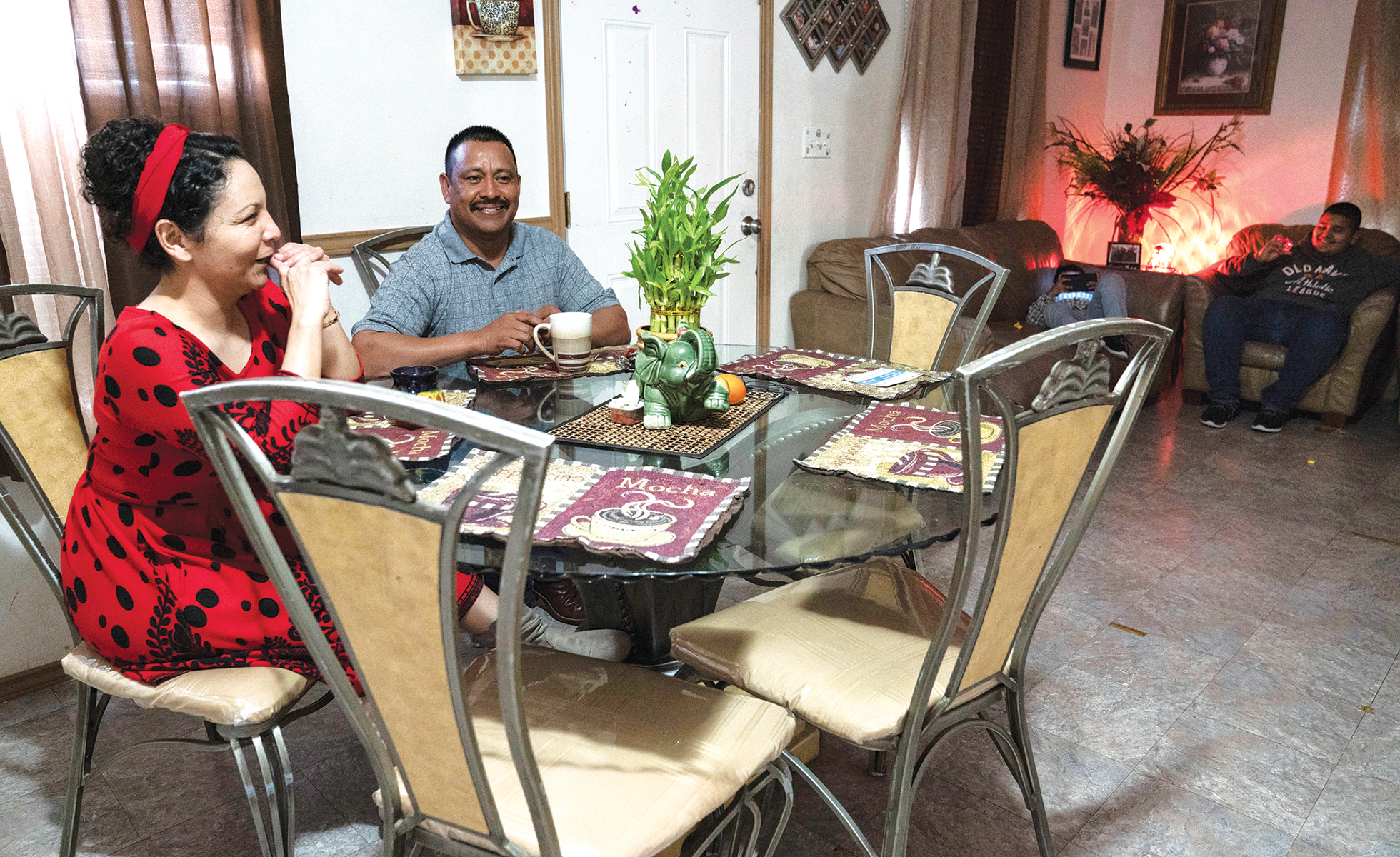
But after the fire, the family couldn’t afford other lodging. Their only income is the $300 to $350 that Capetillo’s husband makes each week as a mechanic. For about a year after the trailer burned, the family of six stayed in a neighbor’s spare room across the street. They had no other options, until, by coincidence, Capetillo heard about Proyecto Azteca, which at the time had a grant to build homes in her neighborhood. Several years later, she watched the floodwaters rise on her street, from inside a far more resilient home—“muchísima, muchísima mejor,” she says. The water came into her backyard, but not her house.
Salinas estimates that less than 10 percent of the colonia’s 1,500 or so homes ended up being evacuated. Those who stayed, like Capetillo and her family, ended up stuck in the colonia for nearly a week, says Fuentes, who helped with evacuations that night. He returned over the next few days in trucks and on rafts to help people needing medical services like dialysis get out. Proyecto Azteca and other groups organized food and water donations.
Almost exactly a year later, in June 2019, the region flooded again. When I ask if she’s nervous about flooding in the future, Capetillo hesitates and shakes her head. “Whatever Jesus brings,” she says in Spanish as she stirs a pot of beans on the stovetop. The tops of the kitchen cabinets are lined with trophies belonging to her eldest son, who, she tells me proudly, is a straight-A student determined to get a college scholarship and go into real estate. Capetillo, who spends most of her time volunteering at the nearby church, believes God connected her to Proyecto Azteca and kept the water away from her home two years ago. When the next flood comes, “He’ll get me out.”
She’s been through a lot, Capetillo tells me: “Mi vida no es fácil.” She feels lucky to have gotten her new home, but it’s been a difficult path. It’s not like the American dream, she says—she wants to make sure I include that in the story.
